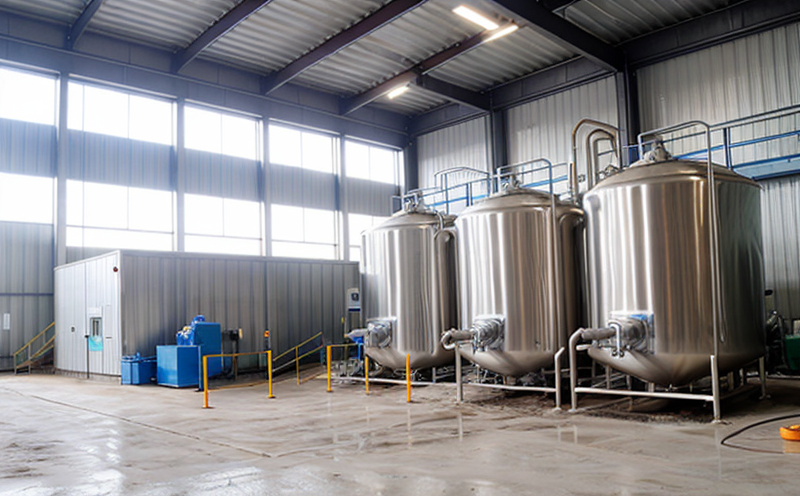EPA 200.7 Elements by ICP AES Test in Industrial Water
The EPA Method 200.7 is a widely recognized and stringent protocol for the analysis of trace elements in water samples, particularly relevant to industrial processes where stringent quality control and compliance are paramount.
This method uses Inductively Coupled Plasma Atomic Emission Spectroscopy (ICP-AES) instrumentation that offers high sensitivity, selectivity, and accuracy. The process involves several critical steps, including the collection of industrial water samples, digestion in a mixture of nitric acid and hydrogen peroxide to release elements into solution, and subsequent analysis using ICP-AES.
The primary elements targeted by this method include arsenic (As), cadmium (Cd), chromium (Cr), copper (Cu), lead (Pb), mercury (Hg), nickel (Ni), selenium (Se), silver (Ag), and zinc (Zn). Each of these elements has specific significance in industrial water management:
- Arsenic: A toxic metalloid that can cause health issues even at low concentrations.
- Cadmium: Used in batteries, pigments, and alloys but is harmful to human health and the environment.
- Copper: Essential for industrial processes like water treatment but can be toxic if present above certain levels.
- Lead: A known neurotoxin that can cause significant health problems, especially at elevated concentrations in drinking water.
- Mercury: Highly toxic and can have severe adverse effects on human health and the environment.
- Nickel: Used in various industrial applications but is harmful to aquatic life if present in high concentrations.
- Selenium: Essential for human nutrition, yet excessive levels are detrimental to both humans and the environment.
- Silver: Widely used in water purification systems, but its presence must be controlled to avoid adverse effects on ecosystems.
- Zinc: Important in many industrial applications, but like other metals, it can pose risks if not properly managed.
ICP-AES analysis is a robust method for measuring these elements because of its ability to accurately detect trace amounts (
The method is particularly important in industries like manufacturing, mining, pharmaceuticals, and electronics where even minor contamination of industrial process water can have significant consequences. Compliance with EPA standards ensures that these processes are conducted safely and sustainably. The results from this test provide critical data to quality managers, compliance officers, and R&D engineers to make informed decisions about water treatment processes.
| Standard | Description |
|---|---|
| EPA Method 200.7 | Describes the procedure for measuring trace elements in water by ICP-AES. |
| ISO/IEC 17025:2017 | International standard for technical competence of testing and calibration laboratories. |
Applied Standards
The analysis of industrial process water using EPA Method 200.7 adheres strictly to the protocols outlined in EPA 200.7. This method is designed to ensure accurate and reliable measurement of trace elements, which are critical for maintaining compliance with environmental regulations.
Alongside EPA 200.7, ISO/IEC 17025:2017 is also a key standard that governs the operational requirements and technical competence of testing laboratories. Compliance with this standard ensures that all laboratory procedures are conducted in a manner consistent with international best practices.
| Standard | Description |
|---|---|
| EPA Method 200.7 | Describes the procedure for measuring trace elements in water by ICP-AES. |
| ISO/IEC 17025:2017 | International standard for technical competence of testing laboratories. |
Industry Applications
The EPA 200.7 elements by ICP-AES test is indispensable in several critical industries where water quality directly impacts operational efficiency, regulatory compliance, and environmental sustainability:
- Mining: Ensures that the water used in mining processes does not contain harmful levels of heavy metals.
- Fabrication & Manufacturing: Helps in maintaining process water quality to avoid contamination affecting production.
- Electronics: Critical for ensuring the purity of water used in semiconductor manufacturing, where even trace amounts of impurities can cause significant issues.
- Pharmaceuticals: Vital for assuring that drug formulations are not contaminated with harmful elements.
In each of these sectors, the accurate detection and quantification provided by this test method ensure that industrial processes operate within safe parameters. By adhering to EPA standards, companies can demonstrate their commitment to environmental responsibility and operational excellence.
| Industry | Application |
|---|---|
| Mining | Evaluating water used in mining processes for heavy metals. |
| Fabrication & Manufacturing | Monitoring process water quality to avoid contamination affecting production. |
| Electronics | Ensuring the purity of water used in semiconductor manufacturing. |
| Pharmaceuticals | Avoiding contamination with harmful elements in drug formulations. |
International Acceptance and Recognition
EPA Method 200.7 for measuring trace elements by ICP-AES is internationally recognized and accepted in numerous countries. Its widespread use and adherence to global standards like ISO/IEC 17025:2017 ensure that the results are respected worldwide.
- United States
- Canada
- European Union (EU)
- Australia
- New Zealand
The method’s robustness and reliability make it a preferred choice for industries operating across borders, ensuring consistent quality standards. The acceptance of this test in these regions underscores its importance in maintaining international environmental compliance.





